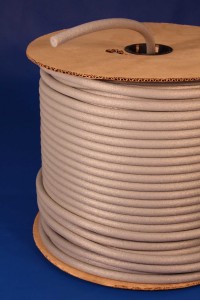When it comes to choosing the right foam for your project, understanding the material’s hardness is essential. With so many foam types and a wide variety of applications—from packaging and insulation to athletic gear and construction—hardness helps determine whether a particular foam will perform as needed. One of the most accurate ways to measure this is through the Shore Durometer test.
What Is a Shore Durometer?
Invented in the 1920s by Albert F. Shore, the Shore Durometer is a specialized tool designed to measure the indentation hardness of a material—how much it resists being compressed. Unlike scratch testing (which compares one material to another), a durometer measures hardness against a standardized control, making it ideal for precision testing.
Most durometers are hand-held devices, featuring a circular dial mounted on a cylindrical body. At the base, a small pin—usually 2.54 mm (0.100 inch) in diameter—protrudes from a flat surface. This spring-loaded pin either presses into or is resisted by the material being tested, and the resulting reading reflects the material’s relative hardness.
Understanding Shore Hardness Scales
Because materials vary so widely in density and flexibility, there are different Shore hardness scales. The most commonly used are:
- Shore A – used for flexible plastics and some rubber materials.
- Shore D – used for harder plastics.
- Shore OO – used for very soft materials like foams and soft rubbers.
Each scale ranks materials from 0 (very soft) to 100 (very hard). However, these scales are not interchangeable; a Shore 50A is not equivalent to a Shore 50OO. To accurately compare materials, they must be measured on the same scale, using the appropriate durometer tool for each. We measure all foam hardness using the Shore OO scale, as it best fits the softer materials we offer.
What Shore Durometer Tells You (and What It Doesn’t)
A Shore Durometer reading gives insight into two key characteristics: flexibility and resistance to pressure. However, hardness alone doesn’t tell the full story. Factors like foam thickness, compression force, and overall use case also impact how the material performs in real-world applications.
For instance, a thinner high-durometer foam might compress more easily under heavy weight than a thicker, lower-durometer foam. This makes durometer readings a great starting point—but not the only metric to consider when selecting foam.
Shore Durometer Ratings for Foam by Mail Products

We provide Shore OO hardness values for five of our most versatile foam products:
- High-Quality Neoprene – Rated around 50 OO, striking a balance between softness and rigidity. This foam is flexible and durable, making it ideal for wetsuits, athletic padding, gaskets, and expansion joint filler in masonry and concrete applications.
- 2 lb. Polyethylene Foam Roll – Rated at 51 OO, this foam is similar in hardness to neoprene but excels in slightly different applications, such as thermal insulation, pressure-sensitive tape backing, packaging, and electronics cushioning.
- 4 lb. Polyethylene Foam Roll – With a 64 OO rating, this foam offers greater firmness while still maintaining some flexibility. It’s well-suited for structural packaging, table pads, running shoe components, and mounting applications.
- 3 lb. Cross-Linked Polyethylene (XLPE) – Our softest tested foam, rated at 45 OO, XLPE is still moderately firm and known for excellent moisture resistance and buoyancy. It’s commonly used in flotation devices, insulation, custom packaging, and thin gasketing thanks to its ability to be cut down to just ¼ inch thick.
Make the Right Choice with the Right Data
When selecting a foam, it’s important to consider the full range of its physical characteristics, including thickness, durability, and application environment. Shore Durometer testing is a valuable tool to help guide your decision, but it’s just one piece of the puzzle.
We’re here to help you choose the right material for your project. Whether you’re customizing packaging, upgrading insulation, or building for industrial use, knowing the hardness of your foam will help ensure long-lasting, high-performance results.


I need a seat cushion that is 16X19 with 4″ thickness that is made of foam which is very hard – we use this for a booster seat for older people who cannot reach our shampoo sink neckline. This is a hair Salon and I am not certain if you can help but I thought I would try. Thank you for getting back with me.
I would suggest our Lux-HQ foam for your application, this is considered a firm foam good for everyday use. You can price out and order that through our website under seats and cushions.
I am looking for a foam that will withstand 300 pounds in a surface area of 1350 square inches. What would you say that the best applicable foam would be?
Please Contact Usfor more information regarding your inquiry.